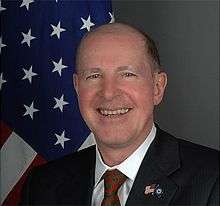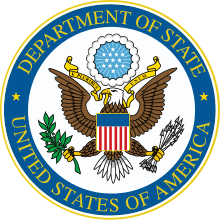United States Ambassador to Slovakia
| Ambassador of the United States to Slovakia | |
|---|---|
|
Seal of the United States Department of State | |
 Theodore Sedgwick since July 4, 2010 | |
| Nominator | Barack Obama |
| Inaugural holder |
Theodore E. Russell as Ambassador Extraordinary and Plenipotentiary |
| Formation | November 22, 1993 |
| Website | U.S. Embassy - Bratislava |
Until 1992 the Slovak Republic had been united with the Czech Republic as the nation of Czechoslovakia. Following World War II, a U.S. consulate was established in Bratislava, but the consulate was closed on May 27, 1950, on the order of the Czechoslovak government, at the height of the Cold War. In 1990 the consulate was reestablished in Bratislava. The Consulate was upgraded to the status of Consulate General on October 21, 1991. In June 1992, the Slovak parliament voted to declare sovereignty and the Czech-Slovak federation dissolved peacefully on January 1, 1993. The United States recognized the Slovak Republic as an independent state and established diplomatic relations with it on January 1, 1993. The embassy in Bratislava was established January 4, 1993, with Paul Hacker as Chargé d’Affaires ad interim. He was replaced by Eleanor Sutter on July 7, 1993. The first ambassador, Theodore E. Russell was commissioned to Slovakia on November 22, 1993. The United States has maintained diplomatic relations with Slovakia since 1993.
Ambassadors
U.S. diplomatic terms
After 1915, The United States Department of State began classifying ambassadors as career Foreign Service Officers (FSOs) for those who have served in the Foreign Service for a specified amount of time.
Political appointee
A person who is not a career foreign service officer, but is appointed by the president (often as a reward to political friends).
Appointed
The date that the ambassador took the oath of office; also known as “commissioning”. It follows confirmation of a presidential appointment by the Senate, or a Congressional-recess appointment by the president. In the case of a recess appointment, the ambassador requires subsequent confirmation by the Senate.
Presented credentials
The date that the ambassador presented his letter of credence to the head of state or appropriate authority of the receiving nation. At this time the ambassador officially becomes the representative of his country. This would normally occur a short time after the ambassador’s arrival on station. The host nation may reject the ambassador by not receiving the ambassador’s letter, but this occurs only rarely.
Terminated mission
Usually the date that the ambassador left the country. In some cases a letter of recall is presented, ending the ambassador’s commission, either as a means of diplomatic protest or because the diplomat is being reassigned elsewhere and replaced by another envoy.
Chargé d'affaires
The person in charge of the business of the embassy when there is no ambassador commissioned to the host country. See chargé d'affaires.
Ad interim
Latin phrase meaning "for the time being", "in the meantime". See ad interim.
- Theodore E. Russell – Career FSO
- Title: Ambassador Extraordinary and Plenipotentiary
- Appointed: November 22, 1993
- Presented credentials: December 16, 1993
- Terminated mission: Left post March 29, 1996
- Ralph R. Johnson – Career FSO
- Title: Ambassador Extraordinary and Plenipotentiary
- Appointed: January 18, 1996
- Presented credentials: April 4, 1996
- Terminated mission: Left post May 21, 1999
- Carl Spielvogel – Political appointee[1]
- Title: Ambassador Extraordinary and Plenipotentiary
- Appointed: August 3, 2000
- Presented credentials: September 7, 2000
- Terminated mission: Left post April 15, 2001
- Ronald Weiser – Political appointee
- Title: Ambassador Extraordinary and Plenipotentiary
- Appointed: November 26, 2001
- Presented credentials: January 5, 2002
- Terminated mission: Left post December 19, 2004
- Rodolphe M. “Skip” Vallee – Political appointee
- Title: Ambassador Extraordinary and Plenipotentiary
- Appointed: June 21, 2005
- Presented credentials: August 23, 2005
- Terminated mission: Left post December 5, 2007
- Vincent Obsitnik – Political appointee
- Title: Ambassador Extraordinary and Plenipotentiary
- Appointed: November 9, 2007
- Presented credentials: December 6, 2007
- Terminated mission: January 20, 2009
- Keith A. Eddins
- Title: Chargé d'Affaires[2]
- Theodore Sedgwick – Political appointee
- Title: Ambassador Extraordinary and Plenipotentiary
- Appointed: July 4, 2010
- Presented credentials: August 18, 2010
- Terminated mission:
Notes
- ↑ Spielvogel was commissioned during a recess of the Senate. A later nomination of September 28, 2000, was not acted upon by the Senate.
- ↑ Laura Rozen of Politico on 20 January 2010 reported that the Obama administration would name Theodore Sedgwick, a lumber and publishing executive. See: http://www.politico.com/blogs/laurarozen/0110/Obama_names_lumber_exec_as_envoy_to_Slovakia.html
See also
References
- United States Department of State: Background notes on Slovakia
 This article incorporates public domain material from the United States Department of State website http://www.state.gov/r/pa/ei/bgn/index.htm (Background Notes).
This article incorporates public domain material from the United States Department of State website http://www.state.gov/r/pa/ei/bgn/index.htm (Background Notes).
External links
- United States Department of State: Chiefs of Mission for Slovakia
- United States Department of State: Slovakia
- United States Embassy in Bratislava

